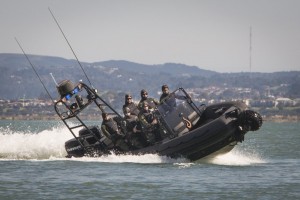NEW BOAT GIVES PETE HIS SEALEGS – SIGHTS SET ON ILLEGAL FISHING IN AFRICA
On Friday 20 April, Pete Bethune launched the new Earthrace vessel at Westhaven Marina in New Zealand. He and his crew have their sights set on tackling illegal fishing off the African coast, starting this summer.
The new craft, which can travel on both land and sea, is named ‘Sealegs’ after the New Zealand-based company of the same name that has developed the vessel for Earthrace. Sealegs is the world’s largest manufacturer of amphibious boats.
This exclusive vessel has been advanced in a number of areas with Earthrace and Sealegs working together. According to David McKee-Wright, Global Sales Manager for Sealegs, the new craft is perfect for the kind of missions that Bethune and Earthrace Conservation will be carrying out. He says, “Our vessels don’t need a boat ramp – they can be launched and landed on almost any beach or pebble shore and that is a great tactical advantage.”
The Sealegs amphibious vessels have been increasingly deployed by law enforcement and military units around the world because of the improved flexibility a land / sea capability offers.
The vessel will be used for sea trials and crew training in New Zealand for several months before being shipped off to Africa where she will be deployed in Fisheries Patrols.
Coastal Africa has seen a dramatic increase in so called pirate fishing recently. This is dominated by vessels from Asia and to a lesser degree Europe that take advantage of Africa’s lack of Navy and Coastguard vessels.
Bethune says that “a few years ago, pirate fishing was limited to offshore areas, but now it is prevalent throughout the inshore fisheries as well. This is having a devastating effect on local communities. It removes local employment, in many cases displacing families that have fished their waters for many generations. It removes from these people their principal source of animal protein, in many cases forcing them to target endangered land wildlife. Finally, it steals from these countries one of the few sources they have for foreign exchange earnings.”
Pete Bethune, who will captain ‘Sealegs’, brought in several members of his unit who have served in the US Navy Seals to help develop the craft. “These guys have been in many maritime combat situations, and they were invaluable in developing the vessel to make it tactically more effective. We changed the vessel layout, the masthead, the electronics, levels of redundancy. The result is a real beast that we believe sets a new benchmark for amphibious assault vessels.”
One example is the seating. Conventional craft have fixed seats, and in normal situations these are fine. When you have a small vessel chasing much larger pirate fishing vessels however, the speed and waves place great strain on the combat personnel through continued impacts. Ullman, a Swedish company specialising in combat boat seats, stepped in with their very latest product that has 150mm of travel to reduce impacts. Crew sit with their legs wrapped astride of the seat, allowing beam impacts to be taken up by the legs, rather than straining the back and arms.
Another example is the FLIR camera mounted on the masthead. This military grade gyro-stabilised unit takes thermal video and places it on the SIMRAD GPS radar screen, allowing the crew to operate more effectively in low-light situations. Bethune says that the boarding of illegal fishing vessels at night is a particularly difficult and dangerous task, and having real-time high resolution thermal video helps in reducing the risk for his team. “It gives us outstanding night vision in total darkness.”
A number of companies, including Sealegs, BRP / Evinrude, SIMRAD, FLIR, Ullman, Explorer Inflatables, Trevor Hansen and Ocean Covers have given substantial support to this latest Earthrace project.
Bethune says they are working with government and military agencies in a number of African countries. The new amphibious vessel will augment the Zodiacs the team has been deploying in Africa until now. There are plans to deploy a number of additional Sealegs vessels into Africa, and to work in training and equipping local enforcement units to effectively remove the illegal foreign fishing operators from their coastal waters.
www.sealegs.com
